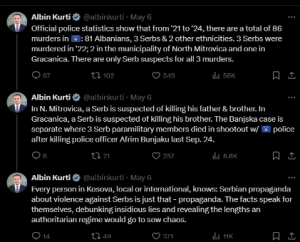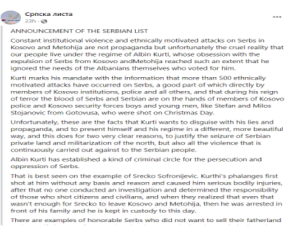Prime Minister Albin Kurti has responded to Serbia’s ongoing claims of ethnically motivated killings and the expulsion of thousands of Serbs from Kosovo in the past three years. In a post on the “X” platform, the head of the executive shared police statistics indicating that out of 86 murders committed from 2021 to 2024, 81 of the victims were Albanian, three were Serbian, and two belonged to other ethnic groups.
Based on the figures he presented, three Serbs were killed in 2022—two in North Mitrovica and one in Gračanica.
“There are only Serb suspects for all 3 murders. In N. Mitrovica, a Serb is suspected of killing his father & brother. In Gracanica, a Serb is suspected of killing his brother.” Kurti wrote.
In the terrorist attack on September 24 of the previous year, three Serbs were killed in a shootout with the Kosovo Police. Kurti emphasized that this was a unique incident, which also resulted in the death of Kosovo Police Sergeant Afrim Bunjaku.

Kurti’s post on “X”
“Every person in Kosova, local or international, knows: Serbian propaganda about violence against Serbs is just that – propaganda. The facts speak for themselves, debunking insidious lies and revealing the lengths an authoritarian regime would go to sow chaos” wrote Kurti.
The Serbian List responded by denying that they are propagandizing about the violence against Serbs.
According to them, during Kurti’s mandate, over 500 ethnically motivated attacks against Serbs have been recorded, directly implicating members of institutions, the Kosovo Police (KP), and the Kosovo Security Force (KSF). The party, which is supported by official Belgrade, cited attacks on Stefan and Milos Stojanović from Gotovuša.
“Unfortunately, these are the facts that Kurti wants to mask with his lies and propaganda, presenting himself and his regime in a more favorable light. He does this for two very clear reasons: to justify the seizure of private Serbian land and the militarization of the north, as well as the continuous violence against the Serbian people,” stated the Serbian List in their response.

The Serbian List’s claim regarding violence against Serbs
Sbunker continuously addresses cases where the Serbian List claims that the Kosovo Police (KP) have mistreated Serbs without cause. Some of those alleged victims have filedcomplaints with the Kosovo Police Inspectorate (KPI), which has confirmed that it is investigating whether police officers exceeded their authority.
Another claim by the Serbian List is that 15 percent of Serbs have left the north since Kurti’s government took office, but this has not been confirmed by official institutions.
The exact number of Serbs who have left the north could be determined after the completion of the ongoing population census. However, the Serbian List has urged Serbs to boycott this process, arguing that participation would only validate the Kurti government’s “success” in expelling Serbs.
The last census was held in 2011, conducted by the municipalities rather than by the Statistical Agency, as it is now. At that time, the process was boycotted by majority-Serb municipalities in the north, as well as the Gračanica and Štrpce municipalities in the south, which are also predominantly Serb.
The Prime Minister published the homocide data in a month when Kosovo’s membership in the Council of Europe is expected to be finalized during the meeting of the Committee of Ministers of this organization, which also emphasizes the rights of minority communities. However, powerful states like France and Germany have requested that the government proceed with the draft statute for the Association of Serb-Majority Municipalities, as a signal that Kosovo guarantees rights for Serbs. Kurti refused to do this, considering it unfair to impose preconditions from another process, such as the dialogue mediated by Brussels.
*This article is published as part of the Western Balkans Regional Initiative against disinformation. Western Balkans Anti-Disinformation Hub: exposing malign influences through watchdog journalism.



